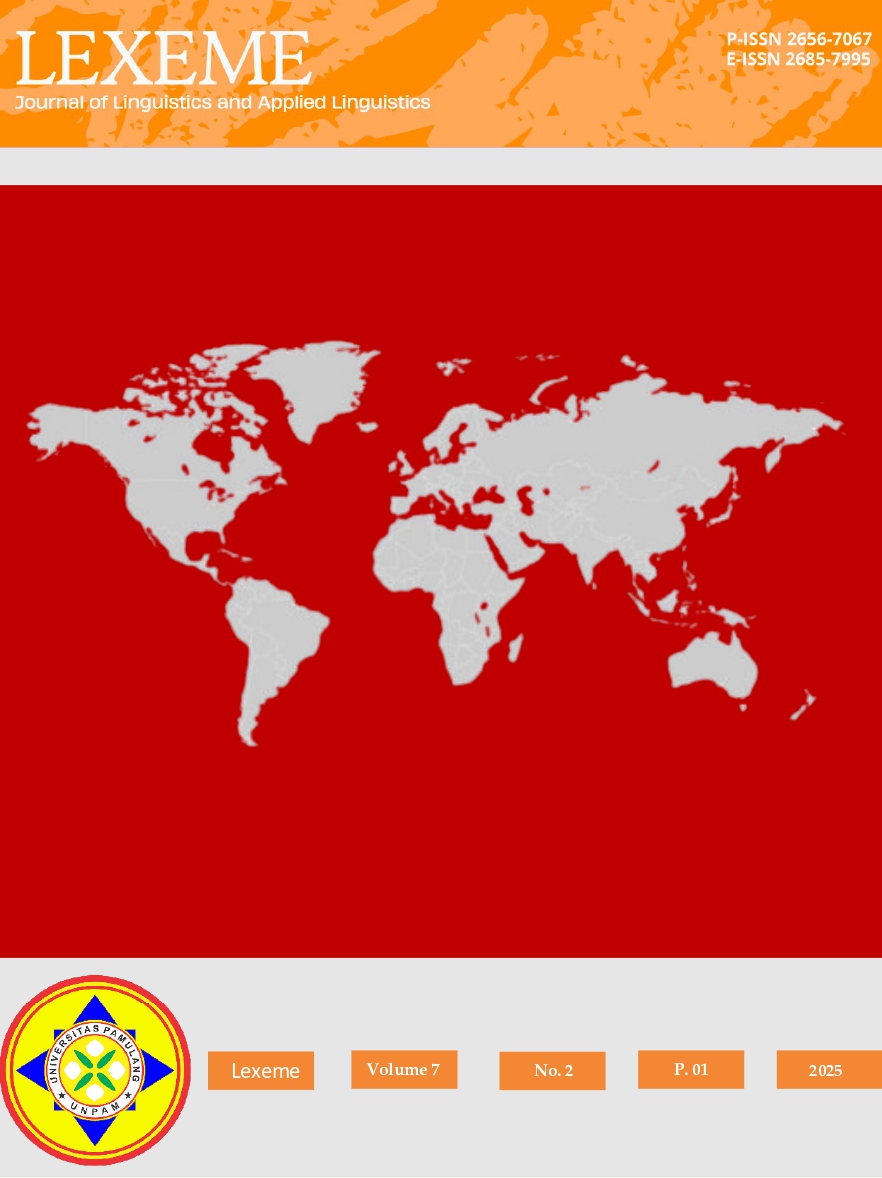When Women Say terserah The Meaning Depends on The Intonation : Women’s Prosody Analysis
DOI:
https://doi.org/10.32493/ljlal.v7i1.45078Keywords:
emotional speech, Praat analysis, prosody analysis, women’s utterancesAbstract
The research aimed to investigate two prosodic variations (intended meaning and unintended meaning) and to deepen the understanding of the emotional nuances conveyed by women's utterances of the word terserah, contributing insights into linguistic communication and emotional expression. This research employed a descriptive qualitative analysis design. Data were collected from women of different ethnic backgrounds and ages, all married to facilitate emotional expression during recording. Three speakers participated in this research: a 31-year-old Javanese woman (P1), a 35-year-old Banjanese woman (P2), and a 40-year-old Bataknese woman (P3). Prosodic elements were measured using PRAAT, a software tool used to analyze prosodic elements such as frequency, intensity, and duration. The findings revealed significant differences between intended and unintended meanings. Intended meaning was characterized by lower pitch, lower intensity, and longer duration with a descending tone. In contrast, unintended meaning exhibited higher pitch, higher intensity, and shorter duration with an ascending tone. In conclusion, the prosodic variations indicate different emotional expressions. However, contextual factors, individual psychological conditions, body language, and facial expressions also play crucial roles in determining the emotional meaning of verbal communication. Therefore, a comprehensive understanding of emotions requires an approach that considers all these aspects together.
References
Bänziger, T., & Scherer, K. R. (2005). The role of intonation in emotional expressions. Speech communication, 46(3-4), 252-267.
Batalemba, I., Badrih, M., & Busri, H. (2024). Kata “anjing” dalam Konten Youtube Asfmine: Kajian Prosodi dengan Pendekatan Fonetik Eksperimental Menggunakan Praat. Jurnal Onoma: Pendidikan, Bahasa, dan Sastra, 10(1), 915-932.
Benus, S., Gravano, A., & Hirschberg, J. B. (2007). Prosody, emotions, and…‘whatever’.
Chang, H. S., Lee, C. Y., Wang, X., Young, S. T., Li, C. H., & Chu, W. C. (2023). Emotional tones of voice affect the acoustics and perception of Mandarin tones. Plos one, 18(4), e0283635.
Colorado, D., Shih, C., & Kochanski, G. Prosody and Prosodic Models. In Proceedings of.
Crystal, David. (1989). The Cambridge Encyclopedia of Language. Cambridge University Press.
Denes and Pison. (1993). The Speech Chain: The Physics and Biology of Spoken Language. United States of America.
Departemen Pendidikan Nasional. (2008). Kamus Besar Bahasa Indonesia Pusat Bahasa Edisi Keempat. Gramedia Pustaka Utama.
Ekberg, M., Stavrinos, G., Andin, J., Stenfelt, S., & Dahlström, Ö. (2023). Acoustic features distinguishing emotions in Swedish speech. Journal of Voice. 1-10.
Ertürk, A., Gürses, E., & Kulak Kayıkcı, M. E. (2024). Sex-related differences in the perception and production of emotional prosody in adults. Psychological Research, 88(2), 449-457.
Fónagy, I., & Magdics, K. (1963). Emotional patterns in intonation and music. STUF-Language Typology and Universals, 16(1-4), 293-326.
Hammerschmidt, K., & Jürgens, U. (2007). Acoustical correlates of affective prosody. Journal of voice, 21(5), 531-540.
Heryono, H. (2019). Pengukuran pitch dan intensity diftong tertinggi menggunakan program PRAAT. Jurnal Linguistik Komputasional, 2(2), 47-55.
Heuven, V. J. V., & Zanten, E. V. (2007). Prosody in Indonesian languages: Concluding remarks. LOT Occasional Series, 9, 191-202.
Ladefoged, P. (1996). Elements of Acoustic Phonetics. The University of Chicago Press.
Larrouy-Maestri, P., Poeppel, D., & Pell, M. D. (2024). The Sound of Emotional Prosody: Nearly 3 Decades of Research and Future Directions. Perspectives on Psychological Science, 17456916231217722.
Mozziconacci, S. (2002). Prosody and emotions. In Speech Prosody 2002, International Conference.
Oh, C., Morris, R., Wang, X., & Raskin, M. S. (2023). Analysis of emotional prosody as a tool for differential diagnosis of cognitive impairments: a pilot research. Frontiers in Psychology, 14, 1129406.
Rochman, D., Diamond, G. M., & Amir, O. (2008). Unresolved anger and sadness: Identifying vocal acoustical correlates. Journal of Counseling Psychology, 55(4), 505.
Schwartz, R., & Pell, M. D. (2012). Emotional speech processing at the intersection of prosody and semantics. PloS one, 7(10), e47279.
Shields, S. A. (2013). Gender and emotion: What we think we know, what we need to know, and why it matters. Psychology of Women Quarterly, 37(4), 423-435.
Syarfina, T. (2009). Ciri Akustik Bahasa Melayu Deli. USU Press.
Syarfina, T. S., Zein, T. T., & Yusuf, M. (2024). The Exploration of Deli Malay Language Vowels: An Acoustic Phonetic Analysis. Jurnal Arbitrer, 11(1), 39-48.
Tannen, D. (2005). Conversational style: Analyzing talk among friends. Oxford University Press.
Xu, Y. (2019). Prosody, tone, and intonation. In The Routledge handbook of phonetics (pp. 314-356). Routledge.
Xu, Y. (2023). Phonetics of Emotion. In Oxford Research Encyclopedia of Linguistics.
Downloads
Published
How to Cite
Issue
Section
License
Copyright (c) 2024 Dzikri Ilma, Tengku Syarfina, Mahriyun, Dedy Rahmad Sitinjak

This work is licensed under a Creative Commons Attribution-ShareAlike 4.0 International License.







